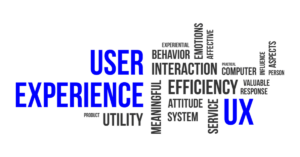User Experience (UX) & Engagement
User Experience (UX) refers to the overall experience of a person using a product, especially in terms of how easy or pleasing it is to use. It encompasses all aspects of the end-user’s interaction with the company, its services, and its products. Good UX aims to fulfill the user’s needs, provide positive experiences that keep users loyal to the product or brand, and ensure the design of products is easy and enjoyable to use.
Engagement, in this context, refers to the degree to which a user interacts with and returns to a product or service. High engagement means that users find value in a product or service, leading them to use it frequently, spend more time on it, or interact with it more deeply.

How AI Helps in User Experience & Engagement
Personalization: AI can analyze user data to create personalized experiences. By understanding user preferences, behaviors, and patterns, AI can tailor content, recommendations, and interfaces to each user, making the experience more relevant and engaging.
Predictive Analytics: AI can predict user needs and behaviors, enabling proactive service and product offerings. This can enhance the user experience by anticipating user needs before they are explicitly stated.
Natural Language Processing (NLP): AI-driven NLP can improve user interactions with virtual assistants and chatbots, making them more intuitive and human-like. This enhances user engagement by providing immediate and accurate responses to inquiries.
Automated Testing and Optimization: AI can automate the process of A/B testing and other optimization techniques for websites and applications. This allows for continuous improvement in the UX based on real user data.
Accessibility: AI can help make products more accessible to people with disabilities, thereby improving the UX for a broader audience. For example, AI can enable voice-to-text features, automatic captioning, and image recognition for the visually impaired.
Behavioral Analysis: AI tools can analyze user behavior to identify patterns and pain points, enabling designers to refine the user experience to meet user needs better.
Top AI Tools for User Experience & Engagement

Google Analytics and Adobe Analytics:
Google Analytics is a web analytics service offered by Google that tracks and reports website traffic. It uses machine learning to identify trends in data, helping businesses understand user behavior. For example, it can segment audiences, track conversions, and provide insights into user acquisition and retention.
Adobe Analytics is part of the Adobe Experience Cloud and offers advanced analytics capabilities. It provides detailed insights into customer journeys across various channels and devices, using AI and machine learning to process vast amounts of data for predictive analytics and anomaly detection.
Chatbots and Virtual Assistants:
IBM Watson Assistant: This tool uses AI to understand natural language and respond to user queries. It can be integrated into websites, applications, and IoT devices to provide automated customer support, handle FAQs, and guide users through complex processes.
Google Dialogflow: Dialogflow allows the creation of conversational interfaces for websites, mobile applications, and IoT devices. Google’s machine learning powers it and excels in understanding and processing natural language queries.
Personalization Engines:
Adobe Target: This tool is a part of the Adobe Marketing Cloud and offers AI-driven personalization. It allows businesses to deliver targeted content and experiences to different segments of their audience based on their behaviors and preferences.
Optimizely: Optimizely is a digital experience platform that provides A/B testing and personalization. It uses AI to automatically allocate traffic to different variations of a webpage to quickly learn which variation performs the best.
User Testing and Feedback Tools:
UserTesting: This platform allows businesses to get real-time feedback from actual users. AI analyzes video recordings of user sessions to identify usability issues, measure emotional responses, and gather qualitative insights.
Hotjar: Hotjar provides heatmaps, session recordings, and surveys to understand user behavior on websites and apps. Its AI capabilities help in aggregating and analyzing data to offer actionable insights.
Content Management and Creation Tools:
MarketMuse: MarketMuse uses AI to assist with content strategy and creation. It analyzes existing content and compares it to a database of web content to identify gaps and opportunities for improvement or new content creation.
Contently: Contently combines an advanced content marketing platform with networked professional content creators. AI is used to match projects with the best-suited writers and to optimize content for engagement and SEO.
AI-Driven Design Tools:
Adobe Sensei: Integrated within Adobe’s Creative Cloud suite, Sensei uses AI and machine learning to automate mundane tasks, analyze images, and help designers with tasks like image editing, creating visual effects, and identifying design patterns.
Voice Recognition Systems:
Amazon Alexa and Google Assistant: Both are voice-controlled intelligent personal assistants. They use AI for natural language processing and machine learning to understand and respond to voice commands, providing a hands-free, conversational user experience.
Each of these tools leverages AI to analyze large datasets, understand user behavior, and automate responses or actions, thereby enhancing the overall user experience and engagement. The choice of tool would depend on the specific needs of the business, such as the type of user insights needed, the level of personalization desired, or the nature of the user interaction preferred.
Future of AI Tools For User Experience (UX) & Engagement

The future of User Experience (UX) and Engagement with AI tools is poised to be revolutionary, driven by continuous advancements in AI technology and a deeper understanding of human-computer interaction. Here are some key trends and possibilities that we can expect to see:
Hyper-Personalization: AI will enable an even more personalized experience for users by learning from their behaviors, preferences, and interactions in real time. This means websites, apps, and digital interfaces will not just adapt to user preferences but also anticipate needs and adapt dynamically.
Seamless Omnichannel Experiences: AI will play a crucial role in unifying user experiences across various platforms and devices. Users will receive a consistent and continuous experience, whether they’re interacting with a brand through a mobile app, website, smart speaker, or even in a physical store.
Advanced Predictive Analytics: Future AI tools will not just analyze past user behavior but will also be able to predict future actions with greater accuracy. This will allow businesses to proactively offer solutions, products, or information, enhancing the user experience and engagement.
Emotion Recognition and Response: AI is expected to evolve in understanding and responding to human emotions. Technologies like emotion AI or affective computing could analyze facial expressions, voice tones, and physiological responses to tailor user experiences based on the user’s emotional state.
Voice and Natural Language Evolution: The interaction with digital interfaces will become more conversational and natural. Voice interfaces and chatbots will become more sophisticated, understanding and responding to natural language with greater nuance and context.
Immersive Technologies: The integration of AI with technologies like Augmented Reality (AR) and Virtual Reality (VR) will create more immersive and interactive experiences. This could revolutionize fields like e-commerce, education, and entertainment.
Accessibility and Inclusivity: AI will continue to make digital experiences more accessible and inclusive, adapting content and interfaces to suit the needs of all users, including those with disabilities. This includes better screen readers, voice-to-text capabilities, and personalized interface adaptations.
Ethical and Privacy-Conscious AI: As AI becomes more integrated into UX and engagement, there will be a stronger focus on ethical AI and privacy. AI systems will need to be transparent, and fair, and respect user privacy, ensuring that personalization does not infringe on user rights.
Continuous Learning and Adaptation: AI systems will evolve to not only adapt to short-term user behavior but also engage in continuous learning over time, allowing for the long-term evolution of the user experience based on changing user needs and global trends.
Cross-Disciplinary AI: The future of UX and engagement will see more cross-disciplinary applications of AI, merging insights from psychology, neuroscience, design, and data science to create more holistic and human-centric experiences.
In conclusion, the future of UX and engagement with AI is about creating more intuitive, personalized, and engaging experiences that not only meet but anticipate user needs, while also being ethical and respectful of privacy. As AI technology continues to advance, it will open up new frontiers for how users interact with and experience digital products and services.
FAQs: AI Tools for User Experience (UX) & Engagement
- What are AI tools in the context of User Experience and Engagement?
- AI tools in UX and Engagement are software and technologies that leverage artificial intelligence to enhance the user’s interaction with digital products, improving personalization, accessibility, and overall user satisfaction.
- How does AI improve personalization in user experience?
- AI improves personalization by analyzing user data such as browsing habits, purchase history, and preferences to tailor content, recommendations, and interfaces to individual users, making their experience more relevant and engaging.
- Can AI in UX design predict user behavior?
- Yes, AI can predict user behavior using predictive analytics, which analyzes past user interactions to forecast future actions, helping in proactive service and product offerings.
- What role does Natural Language Processing (NLP) play in enhancing user engagement?
- NLP allows AI tools to understand and process human language, enabling more intuitive and efficient interactions with chatbots and virtual assistants, thereby enhancing user engagement.
- How do AI tools help in optimizing the user experience through testing?
- AI tools can automate A/B testing and user feedback analysis, quickly identifying the most effective design elements and user pathways, leading to continuous improvement in UX.
- What is the importance of AI in creating accessible digital products?
- AI contributes to accessibility by enabling features like voice recognition, predictive text, and content adaptation, making digital products usable and enjoyable for people with various disabilities.
- Can AI in UX handle emotional responses from users?
- Emerging AI technologies are being developed to recognize and respond to human emotions, though this area is still evolving. Affective computing and emotion AI are aimed at interpreting emotional cues from users to tailor responses or content.
- How do AI-driven chatbots enhance customer service and engagement?
- AI-driven chatbots provide immediate, 24/7 customer service, handling inquiries and guiding users with personalized, context-aware responses, which enhances engagement and satisfaction.
- What are some challenges in implementing AI in UX and engagement?
- Challenges include ensuring data privacy, maintaining ethical AI practices, managing the complexity of integrating AI into existing systems, and ensuring AI-driven recommendations or responses are accurate and relevant.
- What is the future potential of AI in the field of UX and engagement?
- The future of AI in UX and engagement includes more advanced personalization, seamless omnichannel experiences, emotional AI, improved accessibility, ethical AI practices, and the integration of AI with immersive technologies like AR and VR.




